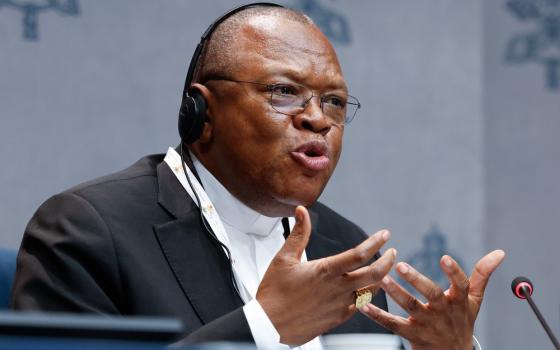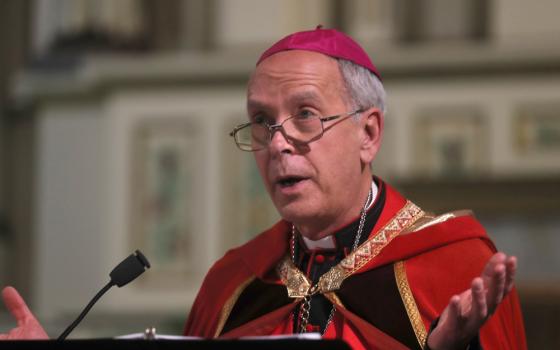Friday of this week, Oct. 7, is the feast of Our Lady of the Rosary. It provides an opportunity to review the origins and purpose of one of the most popular private devotions of the 20th century, and indeed ever since the reported apparitions of the Blessed Virgin Mary, with rosary in hand, to St. Bernadette Soubirous at Lourdes in 1858.
Pope Leo XIII, who was best known for his ground-breaking encyclical on the social order, Rerum novarum (“Of new realities”), in 1891, wrote no less than nine encyclicals on the rosary to promote devotion to it. In fact, he became known in some circles as “the pope of the rosary,” an epithet that might surprise even careful readers of Catholic social thought.
The rosary was also known at one time as the “Psalter of Mary,” which gives us more than a hint of its original purpose. The 150 “Hail Marys” corresponded to the number of psalms in the Bible.
The devotion began sometime in the 12th or 13th centuries. Illiterate Catholics could not read the psalms themselves, and so they used the beads as counters for the “Hail Marys.” Some were also encouraged to meditate on a sequence of mysteries associated with the life of the Blessed Virgin.
The mysteries themselves did not become generally linked with the repetitive “Hail Marys” until the 15th century. Originally there were 15 mysteries, but Catholics commonly recited only five at one time.
The mysteries of Light (or Luminous Mysteries) were added to the Joyful, Sorrowful, and Glorious Mysteries by Pope John Paul II on this feast day in 2002. They are the baptism of Jesus in the Jordan, the wedding at Cana, the proclamation of the Kingdom of God, the Transfiguration, and the institution of the Eucharist at the Last Supper.
Contrary to the common belief among Catholics for whom the rosary is still a popular devotion, the Carthusians had more to do with the cycle of meditations than the Dominicans. The Carthusians influenced the Dominican Alain de la Roche (not St. Dominic), who used the devotion to revive the Dominican Confraternity of the Blessed Virgin Mary.
The rosary gained popularity through the establishment of rosary confraternities in the 15th century, which were increasingly under Dominican supervision, and in 1559 Pope Pius V, himself a Dominican, gave the Master General of the Dominican order exclusive control over these confraternities.
The feast of Our Lady of the Rosary grew out of these confraternities. However, when Christian forces won a decisive sea battle against the Turks at Lepanto, in the Gulf of Corinth, Oct. 7, 1571, (the first Sunday of October, when the feast was generally celebrated by devotees), the victory was attributed to the intercession of Our Lady of the Rosary.
In thanksgiving some say that the same Pope Pius V declared Oct. 7 the feast of Our Lady of Victory (the name of my one and only parish assignment in West Haven, Conn.). Others say that it was the first Sunday in October.
In 1573, Pius V’s successor, Gregory XIII, changed the name of the feast to Our Lady of the Most Holy Rosary. In 1716, the feast was extended to the whole church in thanksgiving for yet another Christian victory over the Turks. Finally, in 1913 the date of the feast was fixed at Oct. 7.
There was an upsurge in devotion to the rosary, as noted above, because of the reported Marian apparitions to Bernadette Soubirous at Lourdes. Pope Leo XIII’s nine encyclicals also helped.
The rosary remained a very popular devotion through most of the twentieth century, even though many more millions of Catholics could now read. Holy Cross priest Patrick Peyton popularized the daily recitation of the Rosary through his slogan, “The family that prays together stays together.”
It also became -- and still is in many places -- a popular devotion at Catholic wakes, although many Catholics do everything in their power to avoid its recitation when the parish priest arrives.
Unfortunately, there have been various blatant misuses of the rosary at weekday Masses in May and October, when it was recited aloud. More frequently, it would be recited quietly during the celebration of Mass as a substitute for the missal.
With the Second Vatican Council came a reorientation of Catholic devotional life, centered on the Eucharist itself and full congregational participation. The Mass was no longer viewed as a backdrop for private devotions.
Pope Paul VI made clear in his apostolic exhortation, Marialis cultus (“On Marian devotion”) in 1974 that the rosary is not to be recited during Mass (n. 48). Many Catholics are still unaware of this teaching.
© 2011 Richard P. McBrien. All rights reserved. Fr. McBrien is the Crowley-O’Brien Professor of Theology at the University of Notre Dame.
A note about last week's column: Writing about Jason Berry’s new book, Render Unto Rome, I noted that Berry listed William Donohue, head of the Catholic League, as one of the supporters of Fr. Marcial Maciel Degollado, founder of the Legionaries of Christ. Donohue disputes the listing and I am only too happy to make this correction.


